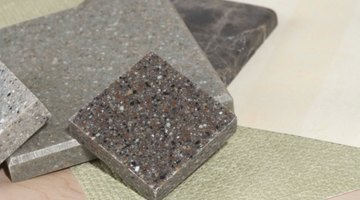How to Use Old Tiles in Gardens
Either whole tiles or bits of tile can be used to add interesting color and designs to garden areas. Ceramic works well in gardens because it is water-resistant and adds stability and structure to other garden materials.

Things You Will Need
- Liquid dish soap
- Large round cake pans
- Vegetable oil
- Concrete mix
- Large bucket
- Trowel
- Pillow case
- Hammer
- Goggles
- Gloves
You can use your imagination to create any number of projects that use old or leftover ceramic tiles, from furniture to garden art. Using old tiles is a good way to recycle materials, and it provides free material for craft projects.
Mosaic Steppingstones
-
Wash the old tiles in liquid dish soap and water. Allow the tiles to dry for an hour.
-
Place the ceramic tiles in an old pillowcase. Break the tiles into a suitable size with a hammer. Generally, the pieces can be about 1 to 3 inches wide and long, depending on your taste.
-
Oil the large cake pan molds generously with vegetable oil. Use about 3 tablespoons of oil for each mold. Make sure the oil gets into the corners and on the edges.
-
Fill a dry cake pan with dry concrete to figure out how much you need and multiply by the number of pavers you plan to make. Mix the concrete according to package directions in a large bucket.
-
Pour the mixed concrete into the oiled molds. Smooth the top with a trowel.
-
Tap the molds gently against the ground to remove air pockets in the concrete.
-
Lay pieces of broken ceramic tile on top of concrete in an attractive mosaic-like pattern. If the concrete is thin and tiles sink, wait five minutes to allow the concrete to harden a bit, then try again
-
Allow the concrete with the tile pieces on top to dry for 24 hours.
-
Tap the edge of the mold against a solid surface like a sidewalk or stairs to remove from the mold. Spreading your hand across the top of the mold to keep the stone from falling out too quickly.
-
Place the steppingstones onto the garden path at about 24 inches apart, center to center. This is a comfortable distance for the average adult gait.
Tile Pot Stands
-
Lay a large ceramic tile face-down on a hard surface.
-
Glue smaller tiles at the corners to create a stable platform, using waterproof glue. Allow the glue to dry, which may take as little as 60 seconds, depending on the glue.
-
Turn the tile face up and set flowerpots or garden containers on top.
-
Place pots with newly created ceramic tile stands around garden areas.
Tile Garden Edging
-
Add soil around flower or vegetable area to create a slightly raised border about the same width as the tile.
-
Place tile along flattened border leaving an even space between tiles.
-
Press the tiles gently into place.
-
Pile soil in a thin rim around the edges of the tiles to create a “lip” to keep the tiles in place.
Tip
If you do not have old tiles available, contact a local tile contractor. They often have remodeling jobs that require the disposal of old tiles. Broken ceramic tiles can be laid at the bottom of pots to provide drainage when planting flowers or vegetables for container gardening. Cement generally comes in large bags. Use only the amount you need, following package directions for amounts. Save the rest for other projects.
Warning
Wear goggles when breaking up ceramic tile to avoid eye injuries.
Use gloves when working with broken pieces of ceramic tile, which may have sharp edges that can cut skin.
When using ceramic tile for outdoor projects that may be walked on, remember that wet tile can be very slippery. Choose tile that has some texture or a slip-resistant finish to prevent accidents.
References
Tips
- If you do not have old tiles available, contact a local tile contractor. They often have remodeling jobs that require the disposal of old tiles.
- Broken ceramic tiles can be laid at the bottom of pots to provide drainage when planting flowers or vegetables for container gardening.
- Cement generally comes in large bags. Use only the amount you need, following package directions for amounts. Save the rest for other projects.
Warnings
- Wear goggles when breaking up ceramic tile to avoid eye injuries.
- Use gloves when working with broken pieces of ceramic tile, which may have sharp edges that can cut skin.
- When using ceramic tile for outdoor projects that may be walked on, remember that wet tile can be very slippery. Choose tile that has some texture or a slip-resistant finish to prevent accidents.
Photo Credits
- Jupiterimages/Comstock/Getty Images
- Jupiterimages/Comstock/Getty Images
More Articles



